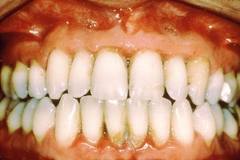With these concepts in mind, let us review the histology of the periodontal pocket, especially in the area of tissue destruction and healing after the periodontal therapy instituted. The periodontal pocket is described as one which occurred with destruction of the supporting periodontal tissues. Progressive pocket deepening leads to destruction of the supporting periodontal tissues and loosening and exfoliation of the teeth. The suprabony pockets are those which the bottom of the pocket is coronal to the underlying alveolar bone. The infrabony pockets are those which the bottom of the pocket is apical to the level of the adjacent alveolar bone and the lateral pocket wall lies between the tooth surface and the alveolar bone. Continue reading
Category Archives: Dental Care Gum
New attachment and reattachment Part 1
The goal of Periodontal therapy is to halt the disease progression and prevent its recurrence, and restore the lost periodontal structure which occured as the result of the disease destruction. The later goal prompts us to evaluate the concept of “new attachment†or “regenerationâ€, and “reattachment†or “repairâ€. Each concepts will lead to different mode of periodontal therapy, and ultimately different result. New attachment is the ideal, desired goal, which each periodontist today are trying to achieve in every possible way. Continue reading
Types of Scalers
The American Academy of Periodontology published a position in paper summarizing what is known about these instruments and how they compare in their effectiveness (J. Periodontol 2000:71;1792-1801). Recent modifications of tip design for power driven scalers provide improved access into deep pockets and difficult to reach areas such as furcations. Therefore, studies were undertaken to shed light on the potential roles of sonic and ultrasonic scalers in periodontal therapy. Continue reading
Kaposi’s sarcoma Part 2
Mouth
Is involved in about 30%, and is the initial site in 15% of AIDS-related KS. In the mouth, the hard palate is most frequently affected, followed by the gums. Lesions in the mouth may be easily damaged by chewing and bleed or suffer secondary infection, and even interfere with eating or speaking. Continue reading
Kaposi’s sarcoma Part 1
Kaposi’s sarcoma (KS) is a tumor caused by Human herpesvirus 8 (HHV8), also known as Kaposi’s sarcoma-associated herpesvirus (KSHV). It was originally described by Moritz Kaposi (KA-po-she), a Hungarian dermatologist practicing at the University of Vienna in 1872. It became more widely known as one of the AIDS defining illnesses in the 1980s. The viral cause for this cancer was discovered in 1994. Although KS is now well-established to be caused by a virus infection, there is widespread lack of awareness of this even among persons at risk for KSHV/HHV-8 infection. Continue reading
Abscess Tooth Symptoms
What is an Abscessed Tooth?
A tooth or dental abscess is a localized collection of pus in a sac formed by disintegration of purulent material from a bacterial infection. Invasion of bacteria which cannot be drained results in abscess. An abscessed tooth can be further classified into periapical, periodontal or gingival abscess depending on its location in the oral cavity.
- Periapical abscess: located at the apex of an infected tooth surrounding the roots. Continue reading
Causes of gum bleeding
Causes of gum bleeding
1.     Gum diseases
A. Gingivitis.
Gingivitis comes from the word “gingiva†which means gums and “-itis†which means inflammation, hence gingivitis means inflammation of the gums. Poor tooth brushing technique or the lack of it leads to accumulation of plaque around the teeth, and eventually leads to gum diseases such as gingivitis. You should suspect gingivitis when you have other symptoms such as :
i)Â Â Â Â Â Â altered appearance of your gums (deep red in colour, soft and swollen appearance, loss of a scalloped and knife-edge shape)
ii)Â Â Â Â discomfort and pain
iii)Â Â Â unpleasant taste
iv) Â Â bad breath or halitosis Continue reading
How to Regrow Gums
Everybody loves to smile, but lately you’ve been hating it because of the state of your teeth and gums. They are a mess, especially your receding gumline. You’re absolutely certain your smile looks more like a jack-o-lantern’s grimace than a genuine expression of warmth. You don’t need to clamp your mouth shut forever, but rather take a stab at a few methods that may help you regrow gums. Gum disease is the leading cause of extensive of gum damage. Feel fortunate that you found out the problem before you developed things like loose and sensitive teeth. If you already have sensitive or loose teeth, don’t waste any more time. Get yourself back to your dentist to get help with your receding gum problem. It’s always helpful to walk in with some knowledge of the receding gum treatments. Continue reading
Hard Vs. Soft Denture Reline
Denture fitting is so crucial to comfortable use that a slight misalignment can create many far-reaching problems in your mouth. Due to the nature of gums, dentures need adjustments from time to time to properly fit. Gums and jawbone shrink with time as part of the natural aging process. Dentures that may have fit perfectly at first can become unsuitable for chewing as they loosen and slide around. Two types of adjustments are available: hard reline and soft reline. Both types of relines can either be performed in office or by using a do-it-yourself denture reline kit. Continue reading
Flying With an Abscessed Tooth
Illness during a flight may lead to an unscheduled landing. This is expensive for the airline and extremely inconvenient for other passengers. There are relatively few situations where travel by flight is not allowed, and having a tooth abscess is one of them. Although the pain might not be so severe to the stage where the aircraft would have to do a force landing, however, different people have different level for tolerance of pain. So it is generally unwise to deliberately fly with a known tooth abscess in the mouth.
Most people are aware that the air gets thinner, providing less oxygen the higher you go. To help deal with this, commercial aircraft are pressurised to the equivalent of an altitude of 1500-2000m. This still results in a relatively small fall in oxygen saturation of the order of 3-5%, which may be significant for travellers whose oxygenation is already compromised by severe cardiac/respiratory disease. In practical terms, people with severe heart or lung disease who can walk 50m on level ground or ascend a flight of 12 domestic stairs are probably fit to fly. Continue reading
